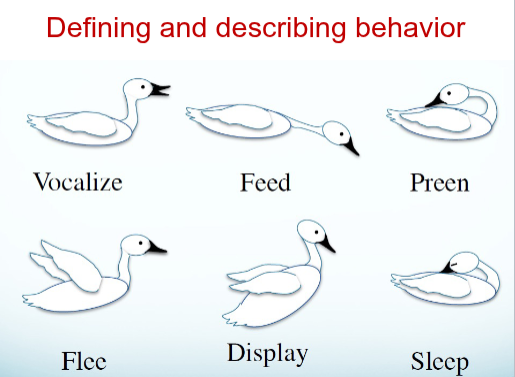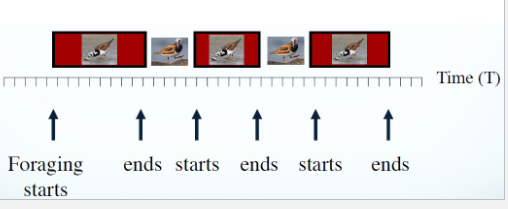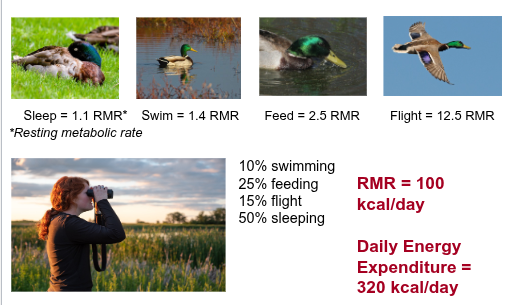L 10 Quantifying animal behavior
1/20
There's no tags or description
Looks like no tags are added yet.
Name | Mastery | Learn | Test | Matching | Spaced |
|---|
No study sessions yet.
21 Terms
Ethology
• Originally developed in Europe—a return to the
natural world (we are skipping Pavlov’s dogs here)
• Also a return to evolution by natural selection,
instead of intentional experience etching
• Focus on the sensory umwelt – “self-centered
world” – the portions of the environment an animal
perceives
Foundational Ethologists
Konrad Lorenz: imprinting on ducklings as mother
Niko Tinbergen: mating ritual
Karl von Frisch: bee waggle dance
How to study behavior
• Descriptive and
discretized
• “Foraging”
• Quantitative
• “Probes/min”
• “Success/probe”
• Unbiased and
representative
• Repeatable

Organize these descriptions into a simple
classification: an ethogram

Measure of behavior
Latency
Frequency
Frequency
number of occurrences in a given
period (i.e., a rate)
Latency
time required for behavior to occur after a
stimulus or starting point
• Frequently, we are scaring animals
Duration
length of time over which a particular
behavior occurs
• Could be the duration of a behavior, or the percent time
over the observation period
Intensity
amplitude of a behavior
• Subjective, descriptive; arbitrary but should be defined
• High-physical contact; Medium-posturing; Low-alert
Sequence
temporal pattern of behavior categories
• A →B → C
• Interactive with other behavior (i.e., # courtship attempts
until copulation)
• Forage, forage, forage, nap


Just to work a quick example... find latency, frequency, total and mean duration, proportion of time, and sequence

Recording methods
• Sampling rules – which individuals to watch when
• Recording rules – specify how the behavior will
be recorded
Sampling Rules – ad lib
• No rules. Watch whoever you want whenever
you want.
• Ok for defining the behavioral repertoire
• NOT valid for quantitative analysis.
Sampling rules – focal sampling
• Watch 1 individual for the
full observation period
• Individual should be
predetermined (not just one
doing something
interesting)
• Random assignment
• Regular assignment (rotate
through everyone)
• Irregular assignment (i.e.,
first to emerge)
• Can also be applied to
groups (focal group)
Estimating Demand – Time Budgets
How much energy does a duck burn being a duck?

Sampling rules – scan sampling
• Rapidly scan the area/group and record the behavior of
each individual
• Easier to account for animals transiting the area
• Should reduce the impact of following weird individuals
Should give the same results as lots of focal
samples if individuals are equa
Sampling rules – behavior sampling
• Every occurrence of a particular behavior is recorded
whenever it occurs
• Useful if you’re interested only in a specific behavior that
is relatively rare
• Typically ignore other behaviors
• Why? Usually they don’t do anything else interesting
Sampling rules – who to watch? (7)
• Ad lib
• Watch randomly
• Good for figuring out to sample more robustlyFocal animal
• Follow an animal for a long time
• Useful, but challenging if they move; remote
monitoring via telemetry can make this possibleScan sampling
• Most common because it’s just too hard to keep
track of individuals for very longBehavioral sampling
• Most often used in controlled settingsRecord all occurrences of behavior
• And start/stop timeProvides complete record, giving true measures
of frequency, duration, latencyReally, you need one human per animal
• Often audio transcription because you can’t be
writing and watching at the same time• Or video and a lot of student workers later
• AI has helped, but not quite as much as you would
think. Yet.
Recording rules – instantaneous recording
• Behavior is sampled at specific intervals; the
total sampling period is broken into short
sampling intervals (e.g., 10s, 1m)
• Often used with scan sampling, but can be
used in focal sampling
• Less busy, but you can easily lose track of
focal individual
• Provides estimates only of proportion of time
spent in different behaviors
• Does not measure frequency, duration, latency, or
sequence
• Inaccurate if sampling interval is longer than the
duration of the behavior or the interval between
Recording rules – measuring sequences
• Requires a continuous recording rule
• Simplify by recording only the order of the behavior, not the time
stamps; you’ll probably regret this later
Quantifying animal behavior
1.Define and describe behavioral repertoire
a) Conduct preliminary observations (ad lib)
b) Define categories that are distinct, unambiguous, and
objective
c) Classify and group behaviors – an ethogram
2.Decide on measure of behaviors to record
a) Latency, frequency, duration, intensity, sequences
3.Decide on recording methods
a) Sampling rules: ad lib, focal, scan sampling, behavioral
sampling
b) Recording rules: continuous, instantaneous, sequences-only